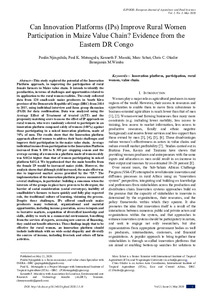| dc.contributor.author | Njingulula, P. |
| dc.contributor.author | Matungulu, P.K. |
| dc.contributor.author | Masuki, K.F. |
| dc.contributor.author | Schut, M. |
| dc.contributor.author | Okafor, C. |
| dc.contributor.author | Wimba, B.M. |
| dc.date.accessioned | 2022-04-19T10:19:23Z |
| dc.date.available | 2022-04-19T10:19:23Z |
| dc.date.issued | 2020-05 |
| dc.identifier.citation | Njingulula, P., Matungulu, P.K., Masuki, K.F., Schut, M., Okafor, C. & Wimba, B.M. (2020). Can Innovation Platforms (IPs) improve rural women participation in maize value chain? evidence from the eastern DR Congo. European Journal of Agriculture and Food Sciences, 2(3), 1-10. |
| dc.identifier.issn | 2684-1827 |
| dc.identifier.uri | https://hdl.handle.net/20.500.12478/7419 |
| dc.description.abstract | This study explored the potential of the Innovation Platform approach, in improving the participation of rural female farmers in Maize value chain. It intends to identify the peculiarities, in terms of challenges and opportunities related to its application to the rural women realities. The study collected data from 120 small scale maize producers in South Kivu province of the Democratic Republic of Congo (DRC) from 2015 to 2017, using individual interview and focus group discussion (FGD) for data confirmation. Data was analyzed using the Average Effect of Treatment of treated (ATT) and the propensity matching score to assess the effect of IP approach on rural women, who were randomly selected to participate in an innovation platform composed solely of women (100%) against those participating in a mixed innovation platform, made of 70% of men. The results show that the Innovation platform approach allowed women to address their basic challenges and improve their participation in the maize value chain. Average individual income from participation to the Innovation Platform increased from $ 100 to $ 300 per cropping season and the average earning of a women in a platform made of women solely was $552.6 higher than that of women participating in mixed platform $432.4. We hypothesized that the main benefits from the female IP would be increased maize yields. However, the analysis shows that although yield increased, the main effect was due to improved market access provided by the IP." The implementation of the innovation platform process encountered several challenges, in particular: building a consensus when the interests of the groups in place have proven to be divergent, the barrier of social consideration (social stereotype), inability of smallholder’s farmers to learn quickly and fully play expected role, the traditional culture of learning, visioning the process. Despite these challenges, IPs offered small-scale maize producers many technical, organizational and material opportunities, including income generation, access to inputs and to lucrative markets, acquisition of diversified knowledge and skills, ability to work in a commercial environment, benefiting from the services of experts, accessing new sources of financing, they could not benefit otherwise. These findings imply that to be effective for rural women, an innovation platform should include individuals with no wide social disparity and diversify the sources of income, including livestock and others off farm activities. |
| dc.format.extent | 1-10 |
| dc.language.iso | en |
| dc.subject | Women Farmers |
| dc.subject | Innovation Platforms |
| dc.subject | Maize |
| dc.subject | Value Chain |
| dc.subject | Participation |
| dc.title | Can Innovation Platforms (IPs) improve rural women participation in maize value chain? evidence from the eastern DR |
| dc.type | Journal Article |
| cg.contributor.crp | Roots, Tubers and Bananas |
| cg.contributor.affiliation | Institut National pour l'Etude et la Recherche Agronomique, DR Congo |
| cg.contributor.affiliation | International Institute of Tropical Agriculture |
| cg.contributor.affiliation | Association for Land use, Environmental care Research and Technology Transfer |
| cg.coverage.region | Africa |
| cg.coverage.region | Central Africa |
| cg.coverage.country | Democratic Republic of the Congo |
| cg.coverage.hub | Central Africa Hub |
| cg.researchtheme | Natural Resource Management |
| cg.identifier.bibtexciteid | NJINGULULA:2020 |
| cg.authorship.types | CGIAR and developing country institute |
| cg.iitasubject | Agribusiness |
| cg.iitasubject | Agronomy |
| cg.iitasubject | Capacity Development |
| cg.iitasubject | Gender |
| cg.iitasubject | Maize |
| cg.iitasubject | Plant Breeding |
| cg.iitasubject | Plant Production |
| cg.iitasubject | Smallholder Farmers |
| cg.iitasubject | Socioeconomy |
| cg.iitasubject | Value Chains |
| cg.journal | European Journal of Agriculture and Food Sciences |
| cg.notes | Open Access Article; Published online: 21 May 2020 |
| cg.accessibilitystatus | Open Access |
| cg.reviewstatus | Peer Review |
| cg.usagerightslicense | Creative Commons Attribution 4.0 (CC BY 0.0) |
| cg.targetaudience | Scientists |
| cg.identifier.doi | https://dx.doi.org/10.24018/ejfood.2020.2.3.16 |
| cg.iitaauthor.identifier | Kande M PAUL MATUNGULU: 0000-0001-5664-951X |
| cg.iitaauthor.identifier | Marc Schut: 0000-0002-3361-4581 |
| cg.iitaauthor.identifier | Chris Okafor: 0000-0003-2162-6101 |
| cg.futureupdate.required | No |
| cg.identifier.issue | 3 |
| cg.identifier.volume | 2 |

